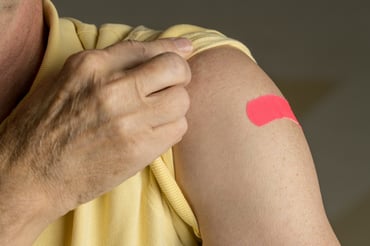
For many men with prostate cancer, prostate removal is never needed because the cancer is often slow-growing and managed with non-surgical treatments. But, if the cancer has grown beyond the prostate, the oncologist may recommend prostate removal surgery, also called a prostatectomy. If you are going to have prostate removal surgery, this information can help you in your discussion with the doctors.
Facts About Prostate Removal Surgery
Prostate cancer surgery can be extremely concerning for many patients. You may be wondering how your surgery will be performed because of your prostate gland’s location. You’ll probably have questions about pain and the side effects — including questions about your sexual life afterward and your ability to control urine.
The good news is that today’s technology offers minimally-invasive prostate removal surgery. The method is known as Robotically Assisted Laparoscopic Radical Prostatectomy (RALP). RALP is the most often used surgical method for prostate cancer. The da Vinci robotic system allows surgeons to use one or more small incisions (about one-half inch in length) for your surgery. Surgeons use a high-magnification 3D camera system to help them operate with accuracy.
Advantages of RALP over traditional surgery include:
- Small incisions
- Less blood loss than in traditional surgeries
- Less pain than an open incision surgery
- Less risk of infection over other kinds of surgery
- Shorter stay in the hospital
- Faster recovery at home
The magnification system provides your surgeon with a clear view of the tiny blood vessels, nerves, and muscles surrounding your prostate to help minimize side effects after your surgery.
Not every man who needs prostate removal surgery will be a candidate for robotic surgery. Each prostate cancer patient’s situation is unique, with some patients requiring a different surgical method — either traditional open surgery or, less frequently, radical perineal prostatectomy.
If you have recently been diagnosed with prostate cancer and are looking for a second opinion on treatment options before undergoing surgery, consult with one of the prostate cancer specialists at Compass Oncology, located throughout the Portland-Vancouver area.
What are the major side effects of prostate cancer surgery?
Prostate surgery removes not only your entire prostate gland but also removes some tissue surrounding your prostate, including the seminal vesicles. These small glands produce the fluid which carries the semen. Some pelvic lymph nodes are usually removed.
There are two major potential side effects of prostate removal.
1. Urinary Incontinence
Urinary incontinence is the inability to control your urine flow, leakage, or dribbling. Not only is incontinence a physical problem for patients to cope with, but it’s an emotional and social problem too. There are several kinds of urinary incontinence.
- Stress incontinence. You might leak when you laugh, cough, sneeze, or exercise. Stress incontinence is the most common kind of incontinence after prostate removal, caused because the valve that controls the flow of urine might not function properly for a few weeks (or months) after surgery.
- Overflow incontinence. You might have problems fully emptying your bladder. Your flow might be a dribble, without much force. A blockage or scar tissue may cause this type of incontinence.
- Urge incontinence. You might experience an urgent need to urinate. The cause is usually because your bladder gets too sensitive to stretch as your body produces urine.
Most men gradually regain control of their bladder over time, ranging from weeks to up to six months. Men over 60 may experience incontinence more often than younger men.
Don’t despair if your incontinence doesn’t go away. Talk to your urologist or other medical team members. They are trained professionals who understand your anxiety and distress. Your doctor may order additional tests to determine the exact cause of your incontinence.
Treatment options for urinary incontinence can include:
- Pelvic floor physical therapy. These specialized physical therapists are trained to help men strengthen their pelvic floor muscles. These muscles help you control the flow of urine. The exercises are called Kegel exercises —just as you might do bicep curls to strengthen your arm muscles; Kegel exercises help you learn to tighten and relax the muscles that control your flow.
- Bladder training. The bladder is a muscular organ that can be trained. A pelvic floor physical therapist or your urologist will provide simple behavioral changes to help retrain your bladder.
- Medication. Prescription medicines help the muscles in your bladder and sphincter (the muscular valve that controls the opening of the valve from your bladder). These medications work well for men with urge incontinence.
- Surgery. Surgery may be scheduled if you have a blockage. Other surgical procedures include injecting collagen to strengthen the urinary sphincter that controls urine release or implanting an artificial urinary sphincter.
Erectile Dysfunction (ED)
Erectile dysfunction (ED) is the inability to get and maintain an erection long enough for satisfying sexual activity. Two small bundles of nerves control your erections. These tiny nerve bundles run along each side of the prostate gland.
Every man experiences erectile dysfunction for a while after prostate removal. Whether you experience longer-lasting ED depends on your age, your general health before surgery, if you experienced ED before your diagnosis, or if those bundles of nerves were affected during surgery. Your surgeon will do everything possible not to injure these vital nerves during surgery. This procedure is known as a nerve-sparing approach. However, prostate cancer sometimes grows into those nerves or is extremely close to those nerves. In this case, your surgeon may need to remove them.
Most prostate cancer specialists believe that regaining your ability to have sex as soon as you heal is an important step in maintaining your ability to get an erection long-term. Your doctor may refer to this process as penile rehabilitation.
Penile rehabilitation after prostate removal may include:
- Prescription medications. Medications, called phosphodiesterase-5 (PDE5) inhibitors, work for many men unless their nerve bundles are damaged or removed. These medications include Viagra and Cialis.
- An injection. Your body makes prostaglandin E1, a substance that helps your body have an erection. A made-made version is now available. Your doctor can teach you to inject this at the base of your penis about 5-to-10 minutes before intercourse. The injection is virtually painless; this medication is also available as a suppository placed into the tip of your penis.
- Vacuum devices. These devices draw the air from around your penis. The vacuum created brings blood into your penis, creating an erection.
- Penile implants. A device is surgically implanted into your penis. Penile implants provide a lasting solution for ED, lasting 10 or 15 years. There are risks, but if none of the other penile rehabilitation methods work, many men agree that a penile implant is a cosmetically-acceptable solution for their prostate cancer-related erectile dysfunction.
Other prostate removal side effects include:
- Changes in orgasm
- Loss of fertility
- Lymphedema – swelling in one or both legs after the removal of lymph nodes during prostate removal
- Change in penis length
- Inguinal hernia – a bulging of fatty tissue or a loop of the small intestine protrudes through a weak area of your groin
Life After Prostate Cancer Treatment
Life after prostate cancer can be as fulfilling as before. Always remember that other men have walked down the same path and faced similar obstacles. Side effects don’t have to rob you of your quality of life. Advocate for yourself. Ask questions. Seek help.
Help Managing Cancer Treatment Side Effects
The team at Compass Oncology is experienced in helping patients treat prostate cancer and manage the side effects of treatment. If you live in the Portland-Vancouver area, have more questions about the side effects of prostate cancer treatment, or need help managing your side effects, request an appointment at one of our locations that's convenient for you. We're here with you every step of the way.




